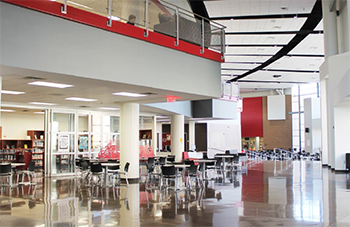PBK Designs High-Tech, Ninth-Grade Hubs
 LEWISVILLE, Texas — Dallas-based PBK Architects designed two ninth-grade centers at Flower Mound High School and Marcus High School in the Lewisville Independent School District, which opened earlier this year. Both centers, which are 110,000 square feet and 108,000 square feet, respectively, are chock full of technology applications that help prepare students for high school.
LEWISVILLE, Texas — Dallas-based PBK Architects designed two ninth-grade centers at Flower Mound High School and Marcus High School in the Lewisville Independent School District, which opened earlier this year. Both centers, which are 110,000 square feet and 108,000 square feet, respectively, are chock full of technology applications that help prepare students for high school.
School Construction News spoke with Irene Nigaglioni, AIA, CEFP, LEED AP BD+C partner and national planning director for PBK, about the 21st century learning elements involved in the design of the ninth-grade hubs.
Q: What was the main goal of the project?
Nigaglioni: The main purpose of the two ninth-grade campuses had to do with providing a secure and safer environment for ninth graders transferring into high school. [The district] decided to build these attached to the existing high schools, but they are self-supporting. At the same time, the adjacent locations allow students to be part of athletics and other parts of the high schools.
[The district] had to relook at the way students learn and came up with a new mission or plan for delivering instruction. This required a more hands-on project based learning setting, and the building was designed as a response to that new initiative.
Q: What are some of the key overall design elements involved?
Nigaglioni: The classrooms are open. One of the first directives given by the superintendent was to make sure there was nothing truly attached to the building. In 10 or 15 years when walls or classrooms are not needed, the walls could be taken away easily. So, classrooms are made in sets of two with walls that can be detached and sliding doorways open into hallways as an extension of the classroom. A wireless system is also provided in the building.
Q: What are some of the key technologies involved?
Nigaglioni: The district launched the 1:X Initiative, which allows have access to technology devices to help them have a personalized educational experience using technology device. With that [technology] in the building, the students have some means to hook up to the network. In each classroom and all collaboration spaces and hallways, there are 80-inch LED screen TVs behind glass, and all have electronic beams so that at any point people can connect physically or for everyday class. They can manage the screens, and teachers can activate it or students can turn it into an interactive board. This allows them to have interactivity.
Q: How do these technologies advance the idea of 21st century learning?
Nigaglioni: Students today relate to technology because they’re born around it. What it allows for them is the opportunity to learn and research and get engaged in a way that they can relate to. Through their iPads or Chromebooks, they can use tools like Google Hangout or Google Docs to communicate and do projects together. It makes them able to work together as a group more rather than independently, which is how everyone truly works in the workforce.
Q: How were the students and staff involved in the project?
Nigaglioni: The students and staff were the ones that truly designed the building. We created a process in which they came into a room where we designed and made decisions together. About 60 to 80 people were involved at these meetings, so they could share what their goals and expectations were. Then, there was this synergy, so some of the parents that might not be so aware of the different ways of learning got an understanding of why this less-traditional learning environment was being made.
Students also sent pictures of where they learn best. So, they took pictures at Starbucks or outside or of their room at home. One interesting thing is that not one single picture was taken of a classroom. That opened the eyes of parents and community members.
Q: How is this project different than ones you’ve completed in the past?
Nigaglioni: I think one of the things that made a big difference was there was a commitment from the district from the top. They made the commitment to change the way they deliver instruction to help the learners and really, truly provide them the best opportunity.
